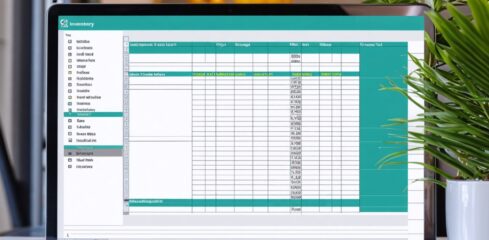9 Most Effective Inventory Management Techniques


Inventory management helps you balance your level of stock to ensure you have enough materials to meet demand without having costly excess goods. By properly managing your inventory, you can ensure your stock levels are accurate, evaluate product performance, provide a better customer experience and save your company money.
You can manage inventory across five stages, including:
- Purchasing: Your company purchases materials from suppliers to create products. You should assess how your suppliers are performing. Mistakes on their end, like incorrect or late deliveries, could cost you revenue. Maintain a solid relationship with suppliers by establishing a culture of mutual communication.
- Production: While wholesalers don’t have to worry about the production process, manufacturers must consider managing inventory during product production.
- Stock storage: With the expenses associated with inventory storage, holding stock can cost businesses money. You’ll have to manage raw materials and products after manufacturing. Inventory management is especially useful when managing stock across multiple locations and channels.
- Sales: Inventory management software can help automate inventory quantity level updates when customers make purchases.
- Evaluation and reporting: Your company should assess inventory levels and evaluate how quickly stock moves through the supply chain and production process. One of the biggest challenges of inventory management is navigating supply chain complexities.
Best practices for inventory management might look slightly different for every company, but here are nine effective techniques to keep in mind.
1. Identify Inventory Management Formulas
You can use several standard formulas when considering effective inventory management systems. Common inventory forecasting and management formulas include:
- Inventory turnover: Your inventory turnover rate reflects how quickly you sell and replace stock in a particular period. Calculating turnover rate is essential to ensure inventory moves at an adequate speed. A high stock turnover rate could indicate increased sales or a lack of necessary inventory, while a low rate reflects excess inventory or a lack of sales. You can calculate inventory turnover rate by dividing the cost of goods sold by your average inventory level.
- Reorder point: Reorder points help you identify when you need to purchase more stock. Reorder points are also called periodic automatic replenishment (PAR) levels, or the minimum amount of inventory you must reorder to keep an item in stock. You can calculate reorder points for inventory forecasting by using minimum and maximum stock thresholds or sales velocity.
- Economic order quantity: This equation suggests the ideal stock quantity when you reorder so you can prevent frequent reordering or excess inventory. The ultimate goal of economic order quantity is to keep inventory costs at a minimum. To calculate economic order quantity, you should consider setup and holding costs and your demand rate.
- Safety stock: Safety stock gives your company extra security. The goal is to maintain adequate inventory levels even if things go wrong. You can lessen the effects of disruptions in the supply chain, broken machinery and delayed delivery with safety stock. Correctly calculating safety stock based on a standard deviation formula is crucial to avoid stockouts.

2. Evaluate Your Needs
Before deciding on an effective inventory management system for your company, you should evaluate your business’s specific needs. Consider what type of product you sell, your customer base, your business’s size, how many selling channels you use, how big your business is and whether your company is growing. You should also assess which stock is most vital for you to count depending on value and customer demand.
One of the first steps in the inventory management process is reviewing your current and previous sales data. Identify the items that are selling the fastest and the slowest. Analyzing inventory performance lets you determine which stock gives you the most sales so you can adjust inventory that requires more frequent reordering.
Inventory management software tracks data so you can ensure you’re following best practices. Data management is one of the most prominent challenges organizations face when managing inventory. You’ll be able to see which products and selling channels are most profitable and which need reevaluation by focusing on key data points.
3. Conduct ABC Analysis
Prioritize your goods based on their value to optimize the stock counting process. ABC analysis suggests how frequently you should audit inventory to ensure you’re focusing on the right products. The most valuable products, or those that carry about 80% of your revenue, are considered “A” stock. This stock accounts for most of your sales volume. However, it can either be in high demand or account for only about 10% of your stock.
“B” stock accounts for about 15% of your revenue and a moderate share of your inventory. “C” stock is slow-moving or dead stock, like seasonal items that account for very little of your total revenue. ABC analysis comes with several benefits, including the ability to forecast demand and maximize resource allocation.
4. Regularly Count Stock
Regularly tracking your stock is crucial to ensure your inventory levels are accurate. Every month, you should establish inventory budgets and ensure stock counts align with them. Maintaining precise stock levels through regular stock auditing comes with several benefits, including:
- Preventing over- or under-ordering.
- Forecasting when to order more inventory.
- Identifying which items are the slowest-moving.
- Assessing issues with the warehouse process.
- Monitoring and increasing profit levels.
Three types of stock auditing you can implement include periodic inventory counting, perpetual inventory counting and cycle counting.

Periodic Inventory Counting
Businesses with lower stock levels typically use periodic inventory counting methods. Periodic stock counting is generally done manually or with automatically updating spreadsheets. Normally, team members physically count inventory at set periods, such as annually, biweekly or quarterly.
Smaller or newer businesses are most likely to benefit from periodic inventory counting. It’s easy to implement and can be done entirely manually. Technology like barcodes and automation can make the process faster. However, periodic inventory counting is still more labor-intensive than other methods.
Perpetual Inventory
Perpetual inventory counting updates inventory in real-time. This method involves changing stock levels every time the inventory changes, like when stock is received, sold or relocated. This type of inventory counting is best for larger organizations with more stock that could span multiple locations.
Beyond the obvious benefits of providing live inventory status updates, perpetual stock auditing systems are less labor-intensive and may reduce human error through automation. However, perpetual inventory reporting costs more than periodic counting upfront. This method is only feasible with the use of technology like barcode scanners.
Cycle Counting
Cycle counting is conducting stock auditing by checking each product on a set, rotating schedule. While how often you should conduct cycle counting depends on your particular industry, higher-priority and valuable items are typically counted most frequently. During cycle counting, you should focus on each product category when it’s most in demand. That way, you can fix problems quickly as they arise.
You can conduct cycle counting with a control group or a random sample. Control group cycle counting accounts for the same kind of items over a specific period. Repeating the process will demonstrate where the counting process has errors. Random sample cycle counting permits auditing during business hours, preventing disrupting a category at one time.
5. Exercise Inventory Forecasting
Multiple factors impact demand, including how much of a particular product you have, your number of sales channels, changes in price, inflation and seasonality. Inventory demand forecasting predicts when specific stock will be in demand. When forecasting industry, you should identify different product life cycles, qualitative evaluations like competitor activity and any outliers in demand. You should also identify particular forecasting periods and methods.
Common approaches to inventory forecasting include:
- Trend forecasting: This type of inventory forecasting tracks changes in customer demand, excluding seasonal demand and outliers. Trends can help you identify when customers might purchase certain products in the future.
- Graphical forecasting: As its name suggests, graphical forecasting plots trends in demand. This method helps you visually track demand changes.
- Qualitative and quantitative forecasting: Although quantitative forecasting methods like numerical sales data are crucial for understanding stock levels, you can also use qualitative data collected through focus groups and other market research to better understand how and when customers purchase particular stock.
6. Consider Using Just-in-Time Inventory
Just-in-time inventory cataloging works when each part of the supply chain operates in perfect synchronization. This inventory management system is incredibly efficient. You only order the supplies and raw materials when you need them to fulfill customer demand. Companies typically use this type of inventory management to save on inventory storage costs. However, incredibly optimized inventory management could lead to empty shelves in stores, making customers potentially think you’re going out of business.
7. Practice the Follow the First-in, First-out Method
First-in, first-out — also known as the FIFO method — helps you limit the amount of time your inventory spends idle. You sell the inventory you first acquired before offering customers new stock. Some products can perish if they’re on the shelves for too long. Product packaging can change, and you could miss out on product updates if you keep older items.
With this strategy, you should first recognize the cost of the inventory you purchase, which will be lower than the stock you most recently purchased. Because of inflation, you’ll be able to sell this inventory at a higher net price than newer inventory. The FIFO method helps you adjust product prices according to inflation levels while aligning cost flow with the flow of goods.
8. Catalog With Barcode Scanners
Barcode scanners save companies time and money by modernizing the inventory management process and limiting the need for manual labor. Using barcode technology also reduces human error. With the computer doing most of the work for you, your accuracy and speed will increase. When your team adds or removes a product, they will need to scan the product and shelf barcode. The rest of the process is automated.
Barcodes can help you in every step of the inventory management process, including receiving shipments and picking and packing. Barcode technology is beneficial when transferring stock, as you’ll be able to know where particular inventory is at any given moment. It streamlines the entire inventory management process and reduces inaccuracies.
9. Use Cloud-Based Inventory Management Software
One of the best practices in inventory management is using cloud-based inventory management software. An off-site center that you can assess via an app or web browser hosts your stock data, allowing you to manage inventory from anywhere with an internet connection.
Beyond convenience, you’ll experience a host of benefits from using inventory management software, including:
- The ability to handle inventory across multiple e-commerce channels: Software makes multichannel stock management much more achievable than traditional methods like spreadsheets. You’ll be able to see sales information about various sites all in one place. The software will automatically update inventory levels across all channels when customers purchase on one site, saving you time and money and preventing stockouts.
- Data security: Cloud-based inventory management software encrypts company data so you can avoid security breaches. You’ll be able to direct your efforts toward the parts of the inventory management process that require more of your attention.
- Automatic data processing: APIs automate the data exchange process, providing solutions for electronic data integration (EDI). You’ll be able to send stock level, purchase orders and new product data electronically, streamlining the process. You can manage all your inventory data through automation. The inventory management software will notify you when stock gets low. When more stock arrives, the software will automatically update new quantities on all channels.
- Cost management: Additional costs like freight, tax and insurance could push you over your budget if you forget to take them into consideration. Inventory management software helps you incorporate these costs into your budget to manage these potentially hidden costs better.
When integrating inventory management software, you should ensure you build your entire system around the software instead of treating it as an additional tool. You should also consider your business’s growth when choosing software. Evaluate whether the software will scale with your company so you can easily add more storage space and avoid costly upgrades.
Partner With Finale Inventory for Inventory Management
When managing inventory, you should evaluate your company and its particular needs, follow common inventory management formulas and strategies and use modern technology like barcodes and inventory management software to maximize efficiency and revenue.
If your business has recently experienced inefficient inventory management, especially during periods of growth, partner with Finale Inventory for effective inventory management software. Our cloud-based software will give you better control over your business, and you and your team will be able to access your inventory data from anywhere with an internet connection.
Our integrations work across multiple platforms for inventory and order management. We offer mobile barcode scanners, label printing services, e-commerce and accounting tools and developer APIs to build custom integrations. Contact us today, start a free 14-day trial or schedule a live product demo to learn how our expert team can help you integrate our software to follow inventory management best practices.






